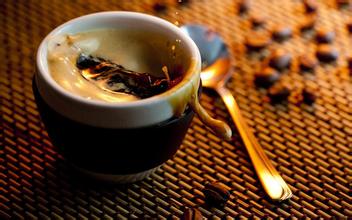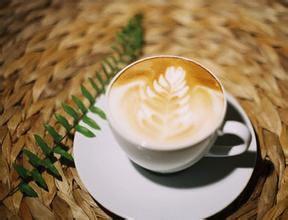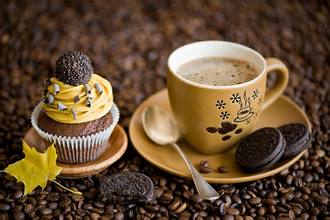Introduction to the production method of filling powder quality and taste of Italian coffee
Espresso
Another key point is to be uniform, and the powder should be uniform in the handle. After the hot water gathers to a pressure of about 9 Pa in the narrow space near the outlet, to rush out of the shackles of pressed powder, the loose place will flow too much and cause excessive extraction. Dense places will flow less and cause insufficient extraction, and all the efforts above will be bullshit. The 9-point full line of the powder bowl is the limit of powder thickness. after receiving the powder from the bean grinder, you should first hit the edge of the powder bowl horizontally with a powder press. In 3 to 4 directions, the interior of the powder is uneven, and horizontal tapping can achieve the goal of roughly average inside. But do not knock too much and for a long time, so that the powder is getting denser and denser, there will be cracks on the upper surface, and then the powder press will be put down, not pressing. Is to turn it so that the powder can be evenly distributed and adjust the powder level again, lift the powder press and hit the powder on the lower edge of the powder bowl, but it can be turned again but less than the first time, find the level again, lift the shock powder, and start to apply vertically. I suggest not turning hard, pay attention to the powder inside and outside the edge of the powder bowl, to prevent water from flowing out of the gap caused by powder! After the end, turn half a circle without pressure (to prevent the powder press from sticking to powder), lift, don't knock again, to prevent pressed powder from being separated from the powder bowl after forming, forming a gap. Pressing powder once is enough, not twice, to prevent pressed powder from detaching from the bowl or too dense.
Other common sense aside, warm cup ~ warm handle ~ and when the relative humidity is high, the powder is coarser, too fine affects the life of the bean grinder and the powder will stick, making pressed powder uneven.
Uniform, non-standard fine-tuning to find the standard, the taste of a cup of espresso is so good or bad that the dust is settled.

Second, hit the milk foam:
Milk is refrigerated in the refrigerator at a temperature of about 4 degrees: it is easy to preserve quality, the milk temperature for iced coffee and the milk temperature for hot coffee are usually 65 degrees and 70 degrees, so the lower the temperature of the milk is, the longer it can be heated, and the milk bubbles are more and finer.
Iced coffee with ice milk bubble, the tool is the milk bubble tank, the milk level should be high and filter a certain height, hit it. Dense holes blow out dense bubbles.
Hot coffee with hot milk foam, 65 to 70 degrees, espresso is 85 to 90 degrees, mixed is about 65 degrees, served in front of guests is more than 60 degrees, the entrance is neither hot nor cold, known as hot coffee.
It has been explained that the principle is because the fat content is higher than 3%, and then changes when heated to form milk bubbles and so on. I used to do well in chemistry and physics, but now the remaining memory fragments can't make me make a "solution:"... "
The day before yesterday, the store ran out of milk, so I forgot to order it, so I had to ride to the supermarket to buy it, so I bought a bottle of "President" skim milk by the way. When I came back, I beat it with steam twice, and it can make milk foam. I remember someone once said that skimmed milk bubbles can also be used to make foam. It is also said that milk bubbles change the properties of protein when heated. Hey, what about the bubble jar? it's not heated? How do you explain it? Everyone has played with soapy water and ate bubbles. I think the principle is the same. What is the surface tension, soapy water is too light to blow long-lasting bubbles, milk? There are few "sticky" ingredients, and there are no lasting bubbles. Many of the milk on the market is too light (impure, add water). You can see from the price that Nestl é milk is neither high nor low, nor pure, but with some thickeners and stabilizers, it has a similar effect to washing powder, right?
Important Notice :
前街咖啡 FrontStreet Coffee has moved to new addredd:
FrontStreet Coffee Address: 315,Donghua East Road,GuangZhou
Tel:020 38364473
- Prev

Modern Romantic Coffee: 10 of the most famous Coffee in the World
1. Mocha coffee shows a strong New York flavor in a small cup. Preparation method: add 20ml chocolate syrup and very strong deep-fried coffee to the cup, stir well, add 1 tablespoon cream to float on top, peel some chocolate powder for decoration, and finally add some cinnamon sticks. two。 Mocha mint coffee: pour warm coffee and cold milk over cold cream
- Next

What do you call roasted coffee beans? introduction to the degree of coffee roasting technology
Coffee roasting is divided into the following degrees: first, very light roasting Light Roast coffee roasting technology the most mild roasting method, the beans are yellowish brown, aroma and concentration are mild light, can be used as the identification standard of the initial stage of roasting. Light baking / cinnamon baking Cinnamon Roast as the name suggests, the beans are cinnamon, slightly stronger in aroma and refreshing than very light baking.
Related
- Beginners will see the "Coffee pull flower" guide!
- What is the difference between ice blog purified milk and ordinary milk coffee?
- Why is the Philippines the largest producer of crops in Liberia?
- For coffee extraction, should the fine powder be retained?
- How does extracted espresso fill pressed powder? How much strength does it take to press the powder?
- How to make jasmine cold extract coffee? Is the jasmine + latte good?
- Will this little toy really make the coffee taste better? How does Lily Drip affect coffee extraction?
- Will the action of slapping the filter cup also affect coffee extraction?
- What's the difference between powder-to-water ratio and powder-to-liquid ratio?
- What is the Ethiopian local species? What does it have to do with Heirloom native species?

